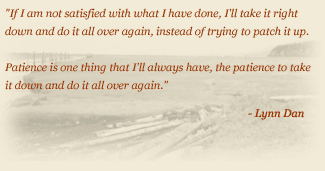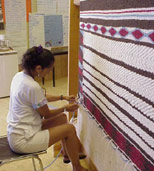

I was born in Chemainus, B.C. We moved to Musqueam in 1964. I got married quite young. I was only seventeen. I have three children, Lorraine is fifteen, and she's the baby, Jeffrey is twenty-two, Alec is twentyfour. I also have two of my nieces with me, Heather and Stephanie Stogan, one for six years, and one going on two years.
In 1984, I was going over to the first weaving school to visit my late friend Margaret Louis and a lot of the other ladies that I knew. They were supposed to graph their weavings after they were done with them, but none of the weavers wanted to do it. So, the instructor Wendy John asked me if I wanted to graph the weavings. After a while, they hired me on a regular basis to sit and weave with them.
I started late with the first weaving school, in 1984. It was towards the end when I joined that one. So, I didn't really have time to learn all the stitches. When Debbie started this last one in 1997, she let me know and I later joined that group as well.
When I first started the class, I was scared to start something, because it all looked so complicated. When they showed me it was just so easy, and I wondered why I didn't want to start at the beginning! I picked up on just about everything right away.
For me, spinning was the most satisfying part in the learning process. If I didn't get it the way I wanted it, then I wasn't happy. Once I got my spinning down just the way I wanted it, then I easily got through the whole weaving itself. Before starting the class, I had known a little bit about spinning the wool, but what I learned in the class was different from the way my mom taught me. When I was younger I just did the pedalling for my mom.
She taught me to just pedal it and then she would be standing way back, spinning the wool. I've still got the old spinner that we used to pedal with [top right]. My mom taught us to split the wool and spin it just like that. You have to do a lot of pulling if you don't rove, or half-spin the wool before you go to the spinning wheel. Wendy taught us to rove before spinning, which is a lot easier than the old-fashioned way.
While in the weaving school in 1997, I mostly did wall hangings. I also made about four or five shawls for a family up on Vancouver Island. I have made sitting blankets for the men, and leggings for mask dancers in the longhouse. It's totally different when you know the person who you are making a weaving for. I put my best into all my weavings, but I put really special feelings into the leggings, because I really know the person that I made them for.
When you know the person, I think the weavings are lighter. Recently, I showed this man from Chehalis some leggings I made for him last year, comparing them to leggings that someone else had done. Mine were really light compared to the other ones. I made him feel the difference in the warping, from somebody else's to mine.
My work is really light. If I am moody I won't touch my weavings, otherwise, my mood makes the weaving heavier. It's the same thing if you are cooking and you're mad. The people that are going to eat it are going to be mad. So, if you are moody and you are working on your weaving, it will be really heavy.
If I am not satisfied with what I have done, I'll take it right down and do it all over again, instead of trying to patch it up. Patience is one thing that I'll always have, the patience to take it down and do it all over again. Two young ones that I had offered to teach got tired of waiting for me, so they got the loom out on their own. I realized that they really wanted to do it. It took them two days to make a little weaving, but they made it right from what they had seen in their own minds. That's what they wanted to weave. I couldn't say, "Well, that's a little bit too hard for you to start this way." They wanted to do what they wanted to do, right away. That's just how I was with the first shawl that I made in 1986. No one had ever done an eagle on a shawl before. That's what I wanted to do, because that was my family pattern. It was hard.
I used my grandma's eagle design on my very first shawl. I gave the shawl to my sister, who lives at Capilano. My grandma made an eagle design herself. She graphed it out. That's the design I use for my weavings. It's mostly for my side of the family. My son got a wool vest with an eagle on it, and he can only wear that in the bighouse.
› View Lynn Dan's Image Gallery




